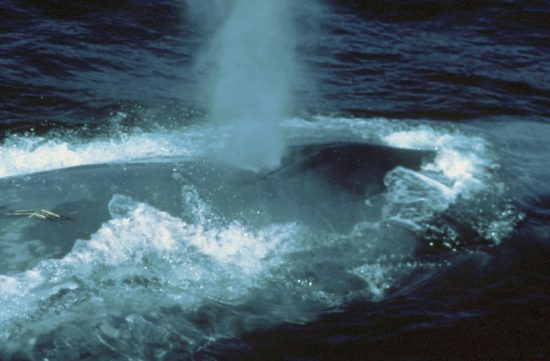




For several years, blue
whales are more frequently being sighted in European waters, be it off the
coast of England, in the Azores or the Canaries Island. Before the early 20th
century, this species had been almost hunted to extinction in these waters.
Today, they are listed as an endangered species by the International Union for
Conservation of Nature.
Currently, there are
only about 12,000 blue whales worldwide. Information about populations in
specific regions is largely unknown. The Whales and Dolphin Conservation
Organisation (WDC) works on various projects globally, geared towards the
protection of this massive animal.
What makes the blue whale so special?
- The blue whale grows up to 33 metres. It
is the largest mammal that has ever lived on the earth. - Blue whales can weigh up to 200 tons. That’s about as
much as 45 elephants, 225 cows or 2,500 people. On land, the weight of their
own skeleton would crush them; whereas in the ocean, they are virtually
weightless.
- Despite their enormous mass, they can reach speeds of
more than 30 km/hr, its powerful blast can reach up to 10 metres high.
- The heart of a blue whale is the size of a small car.
In its main artery a child could float.
- The blue whale’s stomach can hold approximately two
tons of food. It requires about 1.5 million calories. Every mouthful it takes
in can be as much as 80,000 litres of water (including krill); this translates
to 90 times as much energy as what is consumed during a dive.
- The tongue of a blue whale weighs more than four
tons, about as much as a full-grown elephant.
- A baby blue whale is breastfed till it is seven
months old, and drinks several hundred litres of milk daily. At birth, it
weighs two to three tons and is seven metres long.
- The profound and far-reaching calls of the blue whale can reach 188 decibels, surpassing the volume of a jet plane. In this way, they can keep in contact with other
blue whales which may be hundreds or thousands of kilometres away.
The main threats to blue whales today are noise in the ocean, collisions with ships, pollution and
climate change. Due to increasing shipping traffic, seismic surveys, as
well as military sonars and their associated
noise, it is increasingly difficult for the whales to communicate
and orient. Since blue whales have never
learnt how to deal with fast-moving ships, many
blue whales have perished after colliding with them. Trash in the sea and environmental
toxins are additional burdens, while climate change causes their main food
source (krill and small fish) to distribute differently and causes their
populations to shrink.
How can we save the blue
whale from extinction?
In 2014, Chile designated marine reserve
measuring over 70,000 hectares as a sanctuary for whales. Every spring, several
hundred blue whales gather in these waters to feed on the krill population
here. This is a positive move in the right direction, allowing these large
animals to have such a large space dedicated to them, where they can feed, give
birth and raise their young in safety.
Hence, it is important to establish more
of such protected areas where protective measures like the prohibition of
seismic testing and military exercises are in place. Such areas must also be free
from fishing so that a healthy and productive ecosystem can develop. In
addition to these measures, a global strategy that limits the pollution and
littering in the oceans must also be established.
What does the WDC do for blue whales?
Over the years, the WDC has established protected marine areas
worldwide, for example, the Costa Rica Dome in the Pacific. In
addition, the organisation is campaigning against noise in the oceans by participating in multi-group
projects, seeking expert opinions and political support as well as
extensive education of the public.
For many years, it has been working with
an organisation in Sri Lanka to offer regular training workshops about
responsible whale watching for providers of whale-watching tours. This is
essential as more and more of such tours are being organised, so it is
important that the providers observe the proper protocol, such as keeping a
minimum distance from the blue whales. Such workshops have been well received.
How we deal with the blue whale’s situation
affects the state of our oceans. If we do manage to save them from extinction
and preserve their vast habitat, we would at the same time be safeguarding our
own future on this planet.
Source: http://www.whales.org/
WWF also offers a good overview of the research and conservation efforts of the
blue whales: http://www.wwf.de/hoffnung-fuer-blauwale/
 Mares
Mares 16th November 2015
16th November 2015